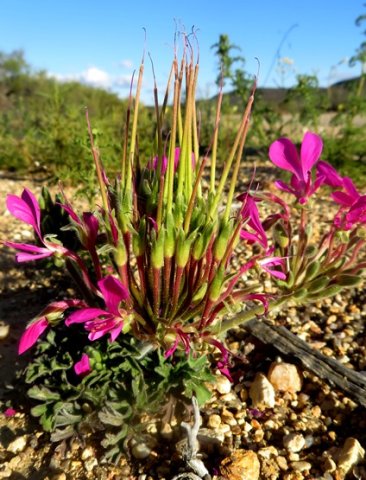Pelargonium incrassatum green fruit

Author: Ivan Lätti
Photographer: Thabo Maphisa
Pelargonium incrassatum flowers turned fruit form an erect, green cluster in picture. No longer a rounded umbel of pink to magenta flowers, the long, red-brown stalks cohere in the slightly disorganised platoon formation one expects from raw recruits. They, after all, perform this manoeuvre only once, not bashing about on a parade ground for hours and days as if life is about group inflicted discipline.
The pointed green calyces in picture have by now survived the flimsier petals, still serving a purpose as stabilising containers folded around the developing ovaries. The tall stork's-bill fruit protrusions at the top end in thread-like style remains, at least for a while. A couple of younger flower umbels in picture on the side are living through earlier stages of the standard inflorescence development sequence.
Hidden in plain sight, the whimsical variability of nature masks much unwavering discipline in the life cycles of species. The unique but endlessly repeated pattern of how to live, the discipline mastered within every specific life cycle, guarantees survival and a future true to the nature of each species. Collectively it constitutes nature.
All this and more wait to be discovered, cherished and respected by people, one more species in the mix of those living on earth and a relative of the others to boot. People sometimes act responsibly in nature as custodian, sometimes below the promise of its specific endowment, becoming a hooligan… both choices are in accordance with attributes embedded in human nature, while only one choice is consistent with humanity's best interests and self-professed best efforts (Manning, 2009; Le Roux, et al, 2005; Eliovson, 1990; iNaturalist).

